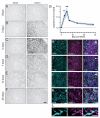Non-Apoptotic Caspase-3 Activation Mediates Early Synaptic Dysfunction of Indirect Pathway Neurons in the Parkinsonian Striatum
- PMID: 35628278
- PMCID: PMC9141690
- DOI: 10.3390/ijms23105470
Non-Apoptotic Caspase-3 Activation Mediates Early Synaptic Dysfunction of Indirect Pathway Neurons in the Parkinsonian Striatum
Abstract
Non-apoptotic caspase-3 activation is critically involved in dendritic spine loss and synaptic dysfunction in Alzheimer's disease. It is, however, not known whether caspase-3 plays similar roles in other pathologies. Using a mouse model of clinically manifest Parkinson's disease, we provide the first evidence that caspase-3 is transiently activated in the striatum shortly after the degeneration of nigrostriatal dopaminergic projections. This caspase-3 activation concurs with a rapid loss of dendritic spines and deficits in synaptic long-term depression (LTD) in striatal projection neurons forming the indirect pathway. Interestingly, systemic treatment with a caspase inhibitor prevents both the spine pruning and the deficit of indirect pathway LTD without interfering with the ongoing dopaminergic degeneration. Taken together, our data identify transient and non-apoptotic caspase activation as a critical event in the early plastic changes of indirect pathway neurons following dopamine denervation.
Keywords: Parkinson’s disease; Q-VD-OPh; caspase-3; dendritic spines; long-term depression; mice; spiny projection neurons; striatum.
Conflict of interest statement
The authors declare no conflict of interest.
Figures




References
MeSH terms
Substances
Grants and funding
LinkOut - more resources
Full Text Sources
Research Materials

